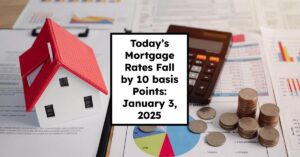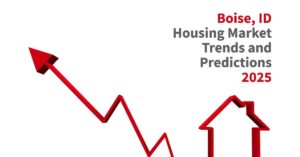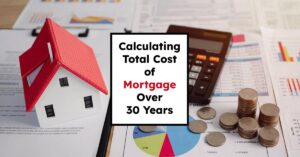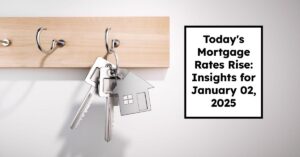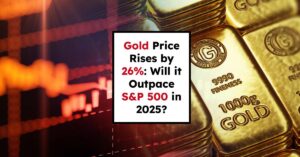If you’re looking to secure a mortgage today, you’ll find that the mortgage rates are showing a slight decrease compared to last week, which could mean a more affordable home loan for you in 2025. As of January 3, 2025, the average 30-year fixed mortgage rate is 6.95%, down from 6.99% last week, while the 15-year fixed mortgage rate has decreased to 6.28%. This shift may be due to various factors, including recent Federal Reserve actions and ongoing economic trends.
Today’s Mortgage Rates Fall Slightly: January 3, 2025 Insights
Key Takeaways
- Current 30-year fixed mortgage rate: 6.95%
- Current 15-year fixed mortgage rate: 6.28%
- 5/1 Adjustable-Rate Mortgage (ARM) rate: 6.52%
- Jumbo mortgage rate: 7.03%
- The rates have seen minor fluctuations, with some trends down and others slightly up.
The world of mortgages can feel overwhelming, especially for new homebuyers trying to make sense of current mortgage rates. These rates are crucial as they determine how much your monthly payments will be. In this post, we’ll break down the current mortgage rates as of January 3, 2025, and examine some of the underlying factors influencing them.
Understanding the Current Mortgage Rates
According to data from Bankrate, today’s average mortgage rates vary based on the loan types and terms. Here’s a detailed look at the current rates:
| Mortgage Type | Today's Rate | Last Week's Rate | Change |
|---|---|---|---|
| 30-Year Fixed | 6.95% | 6.99% | -0.04% |
| 15-Year Fixed | 6.28% | 6.35% | -0.07% |
| 5/1 Adjustable-Rate Mortgage (ARM) | 6.52% | 6.50% | +0.02% |
| 30-Year Fixed Jumbo | 7.03% | 7.00% | +0.03% |
The contributions to these rates stem from various economic factors, including inflation, market conditions, and actions taken by the Federal Reserve. It’s essential to remember that the rates listed are averages, meaning individual circumstances, such as your credit score and down payment, will affect the rates you may actually qualify for.
30-Year Fixed Mortgage: Current Trends
The 30-year fixed mortgage rates are particularly popular among homebuyers due to their predictability. As of January 3, 2025, the average rate stands at 6.95%, a slight decrease from 6.99% last week.
At this rate, if you were to borrow $100,000, your monthly payment for principal and interest would be approximately $661.95. This represents a decrease of $2.68 from the previous week, making it a more attractive option for potential buyers when compared to earlier months.
15-Year Fixed Mortgage Rates
For those looking for a shorter loan term, the average 15-year fixed mortgage rate has dropped to 6.28%, down from 6.35% last week. Monthly payments will be higher on a 15-year mortgage due to the shorter term, with an estimated cost of around $859 for every $100,000 borrowed. This option can save you a significant amount of interest over the life of the loan, although your monthly payments will be higher.
Recommended Read:
Mortgage Rate Predictions January 2025: Forecast for Homebuyers
Types of Mortgages and Their Uses
Understanding the different kinds of mortgages available can help you choose the best option based on your financial needs. Here’s a deeper look into the types of mortgages:
1. Fixed-Rate Mortgages
Fixed-rate loans are ideal for homebuyers who plan to stay in their homes for a significant period. These loans offer monthly payments that remain constant throughout the life of the loan, making budgeting straightforward. They come in various term lengths, with the 30-year and 15-year being the most popular.
2. Adjustable-Rate Mortgages (ARMs)
These loans typically offer lower initial interest rates than fixed-rate mortgages. For the first few years, your rate remains fixed, after which it adjusts at regular intervals based on market conditions. This type of mortgage can be beneficial for those who purchase a home with plans to sell after a few years. However, it carries the risk of increasing payments after the introductory period.
3. Jumbo Mortgages
Jumbo loans are for borrowers seeking amounts that exceed the conforming loan limits set by the Federal Housing Finance Agency (FHFA). Because they don’t conform to size limits, they require stricter credit requirements and higher down payments.
Factors Influencing Mortgage Rates
The dynamics of mortgage rates don’t operate in a vacuum. Various factors play a pivotal role in the determination of these rates:
- Federal Reserve Interest Rate Cuts: The recent Federal Reserve rate cut of 0.25% has influenced mortgage rates, but the correlation is not straightforward. Despite this cut, mortgage rates have risen 0.71 percentage points since reaching their low in September, showcasing the complexities of market reactions to Fed policies.
- Economic Indicators: Mortgage rates often track closely with the yield on the 10-year Treasury note. Investors look at economic indicators such as inflation, employment rates, and consumer spending to determine future movements. Currently, stubborn inflation continues to put upward pressure on rates.
- Global Developments: Geopolitical events also have significant effects on markets. Uncertainty can lead to higher rates because investors demand more to offset the perceived risks.
Recent Trends and Historical Insights
Understanding where we stand today requires a brief look back at how mortgage rates have shifted over the years.
Mortgage Rates Over the Last Five Years
Over the past five years, mortgage rates have experienced significant fluctuations:
- 2020 – 2021: As the pandemic set in, rates hit historical lows, averaging around 3.00 to 3.5%.
- Mid-2021 to 2022: Rates began a slow climb, nearing 4%, due in part to economic recovery efforts.
- 2023: Rates peaked around 7.39% in May, causing many potential buyers to reconsider their plans.
- Late 2023 – early 2025: Rates have begun to stabilize, with slight declines, but remain in the high 6% range.
This historical perspective allows potential homeowners to make more informed decisions by understanding patterns and predicting future movements.
What Lies Ahead for Mortgage Rates in 2025?
Looking forward, predictions for mortgage rates indicate a lack of dramatic changes. Industry experts like Ken Johnson, the Walker Family Chair of Real Estate at the University of Mississippi, believe that 2025 may not see significant drops in mortgage rates. Homebuyers should prepare for rates to remain relatively stable, resting in the high 6% range.
Despite recent declines, homebuyers should remain cautious as the economic landscape continues to evolve.
Summary:
As you navigate the home buying process, understanding today's mortgage rates is essential for making informed financial decisions. Rates are currently stabilizing after recent fluctuations, offering potential buyers a chance to secure affordable financing. Whether you choose a fixed-rate mortgage or an adjustable-rate mortgage depends significantly on your personal financial situation and how long you plan to stay in the home.
Being informed about the latest trends and shifts in the market will help you manage expectations as you seek out your dream home.
Work with Norada in 2025, Your Trusted Source for
Real Estate Investing
With mortgage rates fluctuating, investing in turnkey real estate
can help you secure consistent returns.
Expand your portfolio confidently, even in a shifting interest rate environment.
Speak with our expert investment counselors (No Obligation):
(800) 611-3060
Recommended Read:
- NAR Predicts 6% Mortgage Rates in 2025 Will Boost Housing Market
- Mortgage Rates Predictions for 2025: Expert Forecast
- Half of Recent Home Buyers Got Mortgage Rates Below 5%
- Mortgage Rates Need to Drop by 2% Before Buying Spree Begins
- Will Mortgage Rates Ever Be 3% Again: Future Outlook
- Mortgage Rates Predictions for Next 2 Years
- Mortgage Rate Predictions for Next 5 Years
- Mortgage Rate Predictions for 2025: Expert Forecast
- Prediction: Interest Rates Falling Below 6% Will Explode the Housing Market
- Mortgage Rate Predictions: Why 2% and 3% Rates are Out of Reach
- How Lower Mortgage Rates Can Save You Thousands?
- How to Get a Low Mortgage Interest Rate?
- Will Mortgage Rates Ever Be 4% Again?
